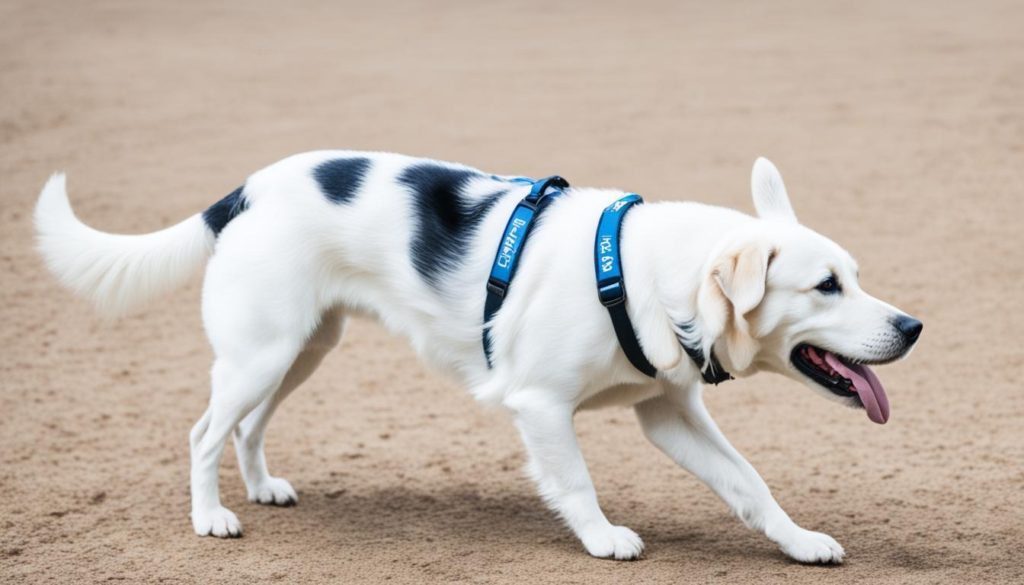Dog body language involves a series of unique methods for communicating emotions and intentions. It can be quite different from how humans communicate with one another. A key aspect of dog body language is the position and movement of their tail. Tail-wagging is often misunderstood, as people tend to think it always means a dog is happy. However, the speed, direction, and position of the wag can indicate different emotions, such as excitement, frustration, or fear. Dogs with their tails between their legs are usually feeling fear and stress, while dogs with their tails held high are feeling confident or even aggressive. Understanding your dog’s tail language is essential for effective communication and building a bond of trust.
Key Takeaways:
- Dog body language involves unique methods of communication.
- Tail position and movement can indicate different emotions.
- Tails between legs signal fear and stress.
- Tails held high can indicate confidence or aggression.
- Understanding tail language is crucial for communication and trust-building.
Interpreting Raised Hackles and Posture
In addition to tail language, dogs also communicate through their body postures. Raised hackles, where the fur along their back stands up, can indicate arousal but not necessarily aggression. It can be a sign of excitement or intense interest in something. Paying attention to the overall posture of a dog is important, as cowering or hunching toward the ground signifies fear or stress. On the other hand, a dog with their weight shifted forward and a twitching tail held high may be displaying offensive intentions. Understanding these body postures can help you interpret your dog’s emotions and prevent potential problems.
When a dog raises its hackles, it means the fur on its back stands up. This can indicate heightened arousal, but it does not always mean aggression. It could be a sign of intense interest or excitement. It is crucial to consider the dog’s overall posture and other cues to accurately interpret its emotions. A dog cowering or hunching down may be displaying fear or stress. Conversely, a dog with its weight shifted forward and a tail held high with a twitching motion may be showing offensive intentions. Understanding these body postures enables you to effectively communicate with your dog and address any potential issues.
Here is a table summarizing different body postures and their corresponding meanings:
| Posture | Meaning |
|---|---|
| Cowering or hunching toward the ground | Fear or stress |
| Weight shifted forward with a twitching high tail | Offensive intentions |
| Raised hackles | Arousal or intense interest |
Remember, it is crucial to consider the context and other body language signals when interpreting a dog’s emotions. By understanding their raised hackles and overall posture, you can better communicate and prevent potentially problematic situations.
Decoding Facial Expressions and Eyes
Dogs communicate their emotions through facial expressions, offering valuable insights into their internal state. While their expressions may differ from humans, understanding them is crucial for comprehending your dog’s body language and emotional well-being.
Yawning: Contrary to popular belief, dogs yawn as a stress response, not out of boredom. It’s a self-calming mechanism used by dogs in tense situations to alleviate anxiety for themselves and others.
Lip-Licking: When a dog licks its lips, it can indicate anxiety or discomfort. It’s important not to misinterpret this behavior as mere hunger or thirst, as it may signal unease or stress.
Dogs’ eyes also play a significant role in conveying their emotional state:
- Soft Eyes: If your dog has relaxed and “soft” eyes, it indicates a sense of calmness and happiness. This expression reflects contentment and well-being.
- Hard Eyes: Conversely, “hard” eyes, which appear tense and narrowed, can signify negativity or aggression. Dogs with hard eyes may be feeling defensive or threatened.
Eye contact and the widening of the eyes, commonly known as “whale eye,” are additional visual cues:
- Eye contact can communicate various messages, such as trust, affection, or even a challenge. However, prolonged and intense eye contact may be perceived as a threat by some dogs.
- “Whale eye” occurs when a dog turns its head away, but the whites of its eyes are still visible. This behavior typically indicates fear or unease and should be respected as a sign of discomfort.
Understanding these facial expressions and eye signals will enable you to better interpret your dog’s body language and emotional state, promoting a safer and more effective means of communication.

Understanding Key Messages from Your Dog
Dogs are highly skilled at using their bodies to communicate their emotions and intentions. By understanding the key messages conveyed through dog body language, you can effectively communicate with your furry friend and strengthen your bond. Here are some important dog communication cues to look out for:
Relaxed and Approachable
- A loose, wagging tail positioned at a medium height or slightly raised
- Relaxed muscles and a neutral posture
- A friendly gaze and soft, relaxed facial expressions
Alert and Curious
- Erect ears and a raised head
- Forward-leaning posture
- Dilated pupils and focused attention
Dominant Aggressive
- Stiff, rigid body posture
- Standing tall and leaning forward
- Ears pricked forward or pinned back
Fearful and Aggressive
- Tail tucked between the legs
- Hunched body or cowering posture
- Snarling or bared teeth
Stressed and Distressed
- Excessive panting, drooling, or licking of the lips
- Pacing or restlessness
- Eyes wide and darting
Fearful and Worried
- Whale eye (wide, sidelong glances with the white showing)
- Tail held low or tucked
- Yawning or lip licking
Extreme Fear with Total Submission
- Crouching or lying completely flat on the ground
- Tail tightly tucked and ears held flat against the head
- Avoiding eye contact and freezing in place
Playfulness
- Play bow (front end crouched low, rear end raised)
- Jumping, bouncing, and wagging tail
- Pawing and inviting gestures
By recognizing and responding appropriately to these key messages, you can ensure a positive and safe interaction with your dog, fostering a deeper understanding and a stronger bond.
Tips for Reading Dog Body Language
When it comes to understanding your dog’s body language, here are some helpful tips to keep in mind:
- Familiarize yourself with your dog’s breed-specific body language. Different breeds may have unique communication cues, so it’s important to understand your specific dog’s breed traits.
- Look at the overall posture and body language of your dog, not just isolated body parts. Pay attention to the combination of tail position, ear position, facial expressions, and overall body tension to get a complete picture of their emotional state.
- Be aware that some body language cues can be subtle, especially in dogs with floppy ears or long hair. Take the time to closely observe your dog’s behavior to pick up on these nuances.
- Understand that certain surgeries, such as tail docking or ear cropping, can affect a dog’s ability to communicate through their body language. Keep this in mind when interpreting your dog’s cues.
- Recognize that dog body language can change over time. As your dog’s behavior and confidence levels evolve, their body language may also shift. Stay attuned to these changes and adapt your understanding accordingly.
Tips for Reading Dog Body Language
To effectively understand your dog’s body language and ensure clear communication, consider the following tips:
-
Familiarize yourself with your dog’s breed-specific body postures: Different dog breeds can exhibit unique body language cues. Take the time to understand the specific body postures commonly seen in your dog’s breed. This knowledge will help you interpret their behavior accurately and respond appropriately.
-
Look at the entire dog’s posture: When observing your dog, pay attention to their overall body language rather than focusing on specific body parts. By considering the complete picture, you’ll gain a more comprehensive understanding of their emotions and intentions.
-
Be aware of subtle cues: Some dogs, particularly those with floppy ears, may exhibit more subtle body language signals. These cues can be easily missed if you’re not paying close attention. Train yourself to observe even the most delicate changes in their posture, facial expressions, and tail wagging.
-
Understand the impact of surgeries: Certain surgeries such as tail docking or ear cropping can affect a dog’s ability to communicate effectively through their body language. Take this into consideration when interpreting your dog’s cues and be aware that their communication signals may be altered as a result of these procedures.
-
Recognize changes over time: Remember that a dog’s body language can change over time as their behavior and confidence levels evolve. Stay attuned to any shifts in their posture and signals, as it may indicate changes in their emotional state or overall well-being.

Reading and interpreting your dog’s body language is a valuable skill that enhances your ability to communicate effectively with them. By observing their breed-specific cues, considering their overall posture, being attentive to subtle signals, acknowledging the impact of surgeries, and recognizing changes over time, you can develop a deeper understanding of your furry friend.
How to Approach a New Dog
When approaching a new dog, it’s crucial to understand their body language to ensure a positive and safe interaction. Dogs communicate primarily through their body postures, and being able to read these signals can help you establish trust and build a connection with the dog. Here are some important guidelines to follow:
- Avoid approaching the dog straight on: Approaching a dog head-on can be perceived as threatening. Instead, approach from an angle or a bit sideways to show that you are not a threat.
- Avoid looming over the dog: Dogs can feel intimidated or scared when someone towers over them. Maintain a lower posture to appear less threatening and more approachable.
- Avoid reaching for the dog’s face: Dogs may interpret reaching for their face as an invasion of their personal space. Instead, allow the dog to initiate contact and offer their head if they feel comfortable.
- Pet the dog on their body rather than their head: While some dogs may enjoy head pats, others may find them uncomfortable or threatening. Start with gentle strokes on the dog’s back or chest.
- Observe signs of fear or aggression: Look for signs such as growling, snarling, or snapping, which indicate that the dog is uncomfortable or stressed. If you notice these signs, it’s best to move away and give the dog space.
Remember that every dog is unique, and individual preferences may vary. Always approach a new dog with caution and respect their boundaries. By understanding and respecting a dog’s body language, you can create a positive and safe environment for both you and the dog.
Ensuring a Positive Approach
Creating a positive approach with a new dog involves more than just understanding body language. Here are some additional tips to ensure a successful interaction:
- Speak softly and avoid sudden movements: Dogs can be sensitive to loud noises and quick motions. Keep your voice calm and gentle and move slowly to help the dog feel more at ease.
- Allow the dog to approach you: Some dogs may be more comfortable initiating contact. Give the dog the space and time to approach you if they feel comfortable doing so.
- Offer treats or toys: In a controlled environment, you can use treats or toys to offer positive reinforcement and build trust with the dog. However, be mindful of the dog’s reaction and adjust your approach accordingly.
A positive approach and understanding of a dog’s body language are crucial for creating a safe and comfortable environment for both you and the dog.
Where to Seek More Information and Advice
To deepen your understanding of dog body language and responsible dog ownership, there are several resources you can explore. Consider consulting certified dog trainers and behaviorists who specialize in canine communication. Veterinarians can also provide advice and rule out any underlying medical issues. Online resources, such as reputable websites and forums dedicated to dog behavior, can offer valuable articles and insights. Engaging with local pet communities and reading books written by experts in canine behavior are also great ways to expand your knowledge.
Conclusion
Understanding your dog’s body language is crucial in establishing effective communication and developing a strong bond of trust. By observing and deciphering their tail language, body postures, facial expressions, and other cues, you can gain a better understanding of their emotions and intentions. This knowledge allows you to respond appropriately to their needs and prevent potential problems.
It’s important to remember that each dog is unique, so taking the time to observe and learn your individual dog’s body language is essential for a deeper connection and enhanced communication. Pay attention to signs such as a dog’s tail between their legs, as it indicates fear and stress. By recognizing these cues, you can provide the support and reassurance your dog needs.
By becoming fluent in your dog’s body language, you can establish a harmonious and fulfilling relationship. Remember to approach new dogs with caution, respecting their boundaries and using their body language as a guide. If you ever have questions or concerns about your dog’s behavior, consult certified dog trainers, behaviorists, or veterinarians who specialize in canine communication. Continuously educating yourself about dog body language and responsible dog ownership will ultimately lead to a happier and healthier life for both you and your furry friend.
FAQ
What are some signs of fear or stress in a dog’s body language?
Dogs may show signs of fear or stress through body language such as tucking their tail between their legs, cowering or hunching toward the ground, and displaying wide eyes or a “whale eye” appearance.
How can I tell if a dog is feeling confident or even aggressive?
Dogs that hold their tails high and have their weight shifted forward with a twitching tail may be displaying confident or aggressive body language.
What does it mean when a dog’s hackles are raised?
Raised hackles, where the fur along a dog’s back stands up, can indicate arousal or intense interest, but not necessarily aggression.
How can I interpret a dog’s facial expressions?
Yawning and lip-licking are signs of stress or discomfort in dogs. Soft eyes indicate calmness or happiness, while hard eyes suggest negativity or aggression. “Whale eye” and widening of the eyes can also convey important messages about a dog’s emotional state.
What are some key messages that dogs convey through their body language?
Dogs can communicate various emotional states and intentions through body language, including relaxed and approachable, alert and curious, dominant aggressive, fearful and aggressive, stressed and distressed, fearful and worried, extreme fear with total submission, and playfulness.
What are some tips for reading dog body language effectively?
Familiarize yourself with your dog’s breed-specific body postures, observe the entire dog’s posture rather than specific body parts, and be aware that body postures can be subtle. Also, understand that surgeries such as tail docking or ear cropping can affect a dog’s ability to communicate, and recognize that body postures may change over time as a dog’s behavior and confidence levels shift.
How should I approach a new dog to ensure a positive interaction?
Avoid approaching a new dog straight on, looming over them, or reaching for their face. Instead, let the dog approach you if they are comfortable, and pet them on their body rather than their head. Observe signs of fear or aggression and move away if necessary.
Where can I seek more information and advice on dog body language and responsible dog ownership?
Consider consulting certified dog trainers and behaviorists, veterinarians, online resources (such as reputable websites and forums dedicated to dog behavior), engaging with local pet communities, and reading books written by experts in canine behavior.
How important is it to understand your dog’s body language?
Understanding your dog’s body language is essential for effective communication and building a strong bond of trust. It allows you to respond appropriately to their needs and prevent potential problems, ensuring a positive and safe interaction.
